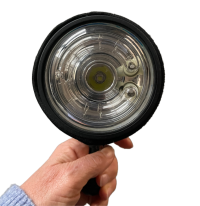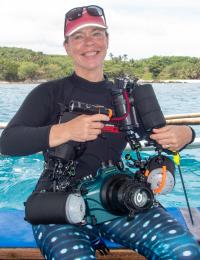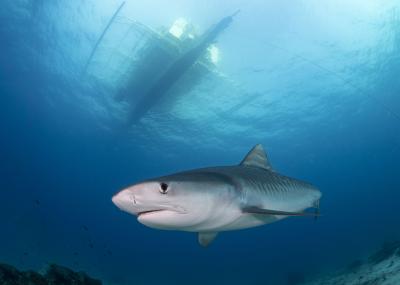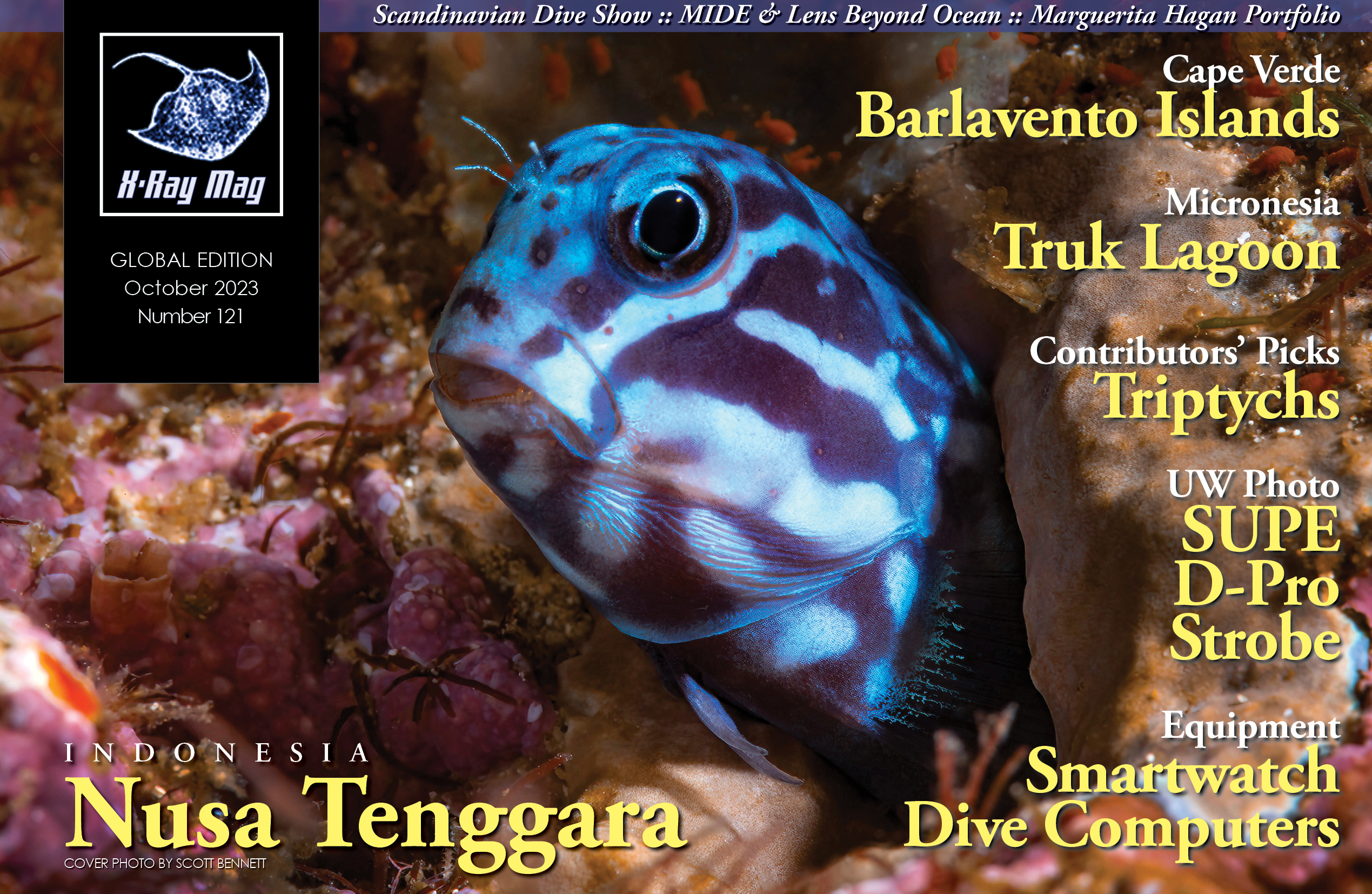Want to know more about the SUPE D-Pro strobe from Scubalamp? Kate Jonker put it through its paces and offers insights from several photographers who have used this strobe in underwater photography.
Contributed by
In the world of underwater photography, quality light is paramount. As an underwater photography coach, I often get asked about choosing the right strobes. It typically comes down to budget and your photography style.
Compact camera and macro enthusiasts can opt for smaller, budget-friendly strobes. However, for those progressing to DSLR or mirrorless cameras, investing in premium strobes is my recommendation. The good news is, once you have invested in quality strobes, you will not need to replace them anytime soon.
Navigating the strobe market can be overwhelming. To make informed decisions, I rely on trusted feedback. In 2021, I was due for an upgrade, and after reading great reviews of the SUPE D-Max strobes from Scubalamp, I decided to purchase a set. I was immediately impressed with their light quality and colour temperature, and they have been my go-to strobes for macro and wide-angle underwater photography ever since.
Earlier this year, SUPE offered to send me their new SUPE D-Pro strobes for a year-long test, and I accepted, keen to explore the impressive specifications of these strobes.

Specifications

The SUPE D-Pro features the following specifications:
• Crafted from anodised aluminium, boasting a sealed battery compartment for added protection
• The SUPE D-Pro can be connected to your camera via fibre optic cable, 5-pin sync cord and used in slave mode.
• Guide number at ISO100: 30
• A robust 160 Ws output
• Circular flash tube with a broad 150-degree beam angle (without diffusers)
• Swift recycle time of 0.1 to 1.1 seconds, allowing for continuous shooting without delay
• An LCD power indicator on the back showing light intensity and battery level
• At low power, it can sync at 10 flashes per second.

• Nine-step manual power controls, offering complete creative control
• On-off and power knobs that are easy to use with gloves
• Equipped with a high-performance SUPE lithium-ion battery pack (3 x 18650 lithium batteries in a sealed unit), which provides 37.8wh for extended dives.
• SUPE battery pack that has a battery life of 500 flashes at full power per charge and 3,000 on lowest power
• Consistent colour temperature of 4,800K, delivering natural and warm hues to your images
• A powerful 500 lumen centre focus/targeting light for precise framing and composition, especially when paired with the SUPE OSD snoot
• Built to withstand the depths, boasting a depth rating of 100 metres (330 ft)
• Size: 170mm x 90mm, designed for easy manoeuvrability
• Land weight of 1,080g without battery, and 120g underwater
• Includes protective neoprene covers to safeguard your strobes during travels
Note: SUPE strobes do not support S-TTL and TTL.
Initial impressions

My Supe D-Pro strobes arrived just two days before a dive trip to Romblon, providing the perfect opportunity to test them in the field.
These strobes come well-protected with neoprene covers, shielding them from scratches and even adding a touch of buoyancy. For added safeguarding during travel, each strobe’s glass has its own neoprene cover.
Inside the box, alongside each strobe, you will find a versatile 1-inch ball mount, ideal for securing the strobe to your arm system, and a sealed matte-red battery pack. Additionally, there is a battery charger and a user manual to complete the package.
I travelled with these strobes in my carry-on, and they did increase my backpack’s weight, so I opted to carry the two battery packs in my jacket pockets to mitigate this somewhat.
Surprisingly, despite their weight on land, underwater, the strobes proved to be neutrally buoyant, making manoeuvring and photography a breeze. The user-friendly control knobs on the back were particularly handy, especially when wearing gloves. Plus, the LCD indicator, which shows the strobe power setting and battery level, was clear and easy to read.
SUPE also included two optional diffusers: the D200 for wide-angle underwater photography and the D210 for macro. They attach to the strobe’s front by being pushed firmly onto an O-ring, although they did not stay as securely as I would have preferred. As a precaution, I secured them to the ball mount with some bungee cords, and they stayed put.
The battery life of these strobes was a real time-saver, easily lasting two full days of diving on a single charge. Recharging was pleasantly quick as well, and it was great not having to take extra batteries along.

Using the SUPE D-Pro strobes
To offer a well-rounded perspective, I reached out to renowned underwater photographers from across the globe who have been exploring the capabilities of these strobes within their specific underwater photography niches.
Wide-angle photography
In the realm of wide-angle underwater photography, achieving an even spread of light is paramount. The SUPE D-Pro’s circular flash tube does just that, casting a wide, uniform light without any noticeable hot spots—even without the optional D200 diffuser. When the diffuser is added, the light becomes even softer, and the beam angle expands farther.

My own experiences with these strobes, while capturing images of the stunning reefs of Cape Town, have been remarkable. The colour temperature they provide truly enhances the vibrancy of our marine life. Despite the occasionally murky winter conditions, I found that removing the diffusers helped with backscatter issues, while the beam remained wide and soft enough to produce high-quality images.
What is more, the strobes’ recycling specifications are quite impressive. This is excellent news for wide-angle underwater photographers, especially when trying to capture fast-moving subjects.

To gain additional insights, I chatted with accomplished wide-angle underwater photographers Scott “Gutsy” Tuason, William Tan and Ferran Sánchez to get their thoughts on the SUPE D-Pros.
“The new SUPE D-Pro underwater strobes allow me to shoot in continuous bursts, so that I can choose a frame of my subject in its best position without missing out on the action,” said Tan.
Sánchez added: “The D-Pro flashes provide the capability to capture underwater photographs with a wide angle and exceptional technical quality. This capability is attributed to their expansive 150-degree beam angle, which is further optimised by combining two flashes, achieving outstanding coverage of underwater scenes. With recharge times ranging from 0.1 to 1.1 seconds, these flashes ensure the capture of every significant moment, eliminating the risk of missing out on valuable photographic opportunities. Moreover, the 4,800K colour temperature enhances colour saturation, adding a striking effect to the final images.”
“With their blazing fast recycle time, ultra-wide beam of soft light and battery power that lasts for days, these are the best strobes I have used in years,” concluded Tuason.
Macro photography
When it comes to the intricate world of macro photography, the D-Pro’s circular flash tube truly stands out. I have personally experienced how its gentle, even lighting works wonders in minimising harsh shadows, allowing for the creation of macro shots that faithfully capture the subject’s colours and details.

Whilst shooting at open apertures, I found that using a low strobe output combined with the D210 diffuser, tailor-made for macro underwater photography, introduced a beautiful softness to the light, preventing overexposed images. Additionally, these strobes delivered ample power when I worked with small apertures to capture minuscule subjects using a strong diopter.
In the underwater world of Romblon, where many subjects move very quickly (particularly the butterfly nudibranchs), I came to appreciate the swift recycle time of these strobes. It enabled me to fire off a continuous stream of shots without any loss of strobe power whatsoever.

To gather further insights into how the SUPE D-Pro performs in the realm of macro underwater photography, I chatted with leading macro underwater photographers Tim Ho and Wayne Jones from Anilao Photo Academy in the Philippines.
“The strobes are close to neutral in the water despite the impression of being big. The batteries have never run dry, even on the busiest of days—and the recycle time is fast, even when “machine-gun” shooting!” said Ho, who also particularly liked that the focus light was placed in the centre of the strobe, making targeting of a snoot accurate. “The SUPE has its own snoot, the OSD, which works perfectly with the D-Pro,” he added.
Jones gave his feedback, saying: “As a dive resort owner focused purposefully on underwater photography, I regularly come into contact with all manner of underwater strobes, and have used a few different brands myself over the years. Now using the well-priced Supe D-Pro strobe, I have been very impressed by its performance for both macro and blackwater photography.”
Blackwater diving

I had been eager to thoroughly test the SUPE D-Pro strobes during some blackwater dives while in Romblon, but our stay coincided with an unseasonal typhoon, and Mother Nature sadly put a damper on those plans.
Nonetheless, my curiosity persisted, and I sought the opinions of accomplished blackwater photographers, including Robert Stansfield from Cozumel in Mexico and Mike Bartick of Crystal Blue Resort at Anilao in the Philippines. I was keen to learn what they had to say about the SUPE D-Pro strobes in the context of blackwater underwater photography.
“These strobes don’t miss a beat so the number of nice shots I’m generating is crazy,” said Stansfield, who told me he was shooting in bursts of four or five photos at a time. “The colour temperature is fantastic, too. I really enjoy the build quality and it is wonderful to no longer have to manage 16 AA batteries. SUPE D-Pro strobes have simplified my world,” he added.

His sentiments were echoed by Bartick, who said, “Speed, reliability and power are the three main components that I look for when considering equipment for shooting wildlife behaviour.”
Optional accessories
The D200 diffuser, designed for wide-angle underwater photography, produces soft, high-quality lighting and extends the already impressive 150-degree spread of light even further.
For macro underwater photography, the D210 diffuser comes in handy, creating softer light in your macro shots. I found it particularly valuable when shooting with wide-open apertures.
Now, let’s talk about the SUPE OSD snoot. When used alongside the SUPE D-Pro, the OSD performs exceptionally well. Its focus light aligns precisely with where your strobe will illuminate. You can delve deeper into my review of the SUPE OSD in X-Ray Mag issue #111.

Conclusion
The SUPE D-Pro Strobe is a versatile powerhouse suitable for both wide-angle and macro photography. With its wide beam angle, consistent performance and rapid recycle times, it excels in capturing underwater moments. Its adaptability spans various photography styles, from wide-angle vistas to macro critters and blackwater subjects, showcasing remarkable versatility. This strobe’s thoughtful design and impressive capabilities should place it among top-tier underwater strobes. ■
Special thanks go to the following photographers: Mike Bartick (facebook.com/mike.bartick), Tim Ho (facebook.com/timscuba), Wayne Jones (facebook.com/1infinitelovejones), Ferran Sánchez (facebook.com/ferran.fotosub), Robert Stansfield (facebook.com/robert.stansfield.7), William Tan (facebook.com/william.tan.7334) and Scott “Gutsy” Tuason (facebook.com/scott.tuason).






































